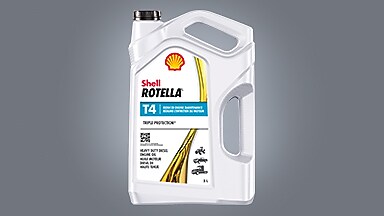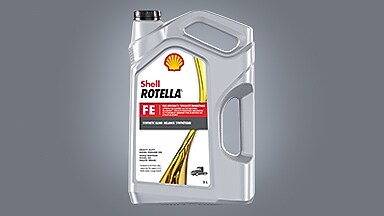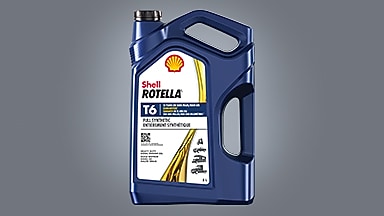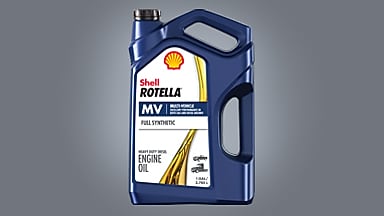
What You Need to Know About Low Diesel Oil Viscosity
The most important property of an oil is its viscosity. Understanding it is more than operationally smart – it’s bottom line-savvy.

Oil viscosity explained
Viscosity refers to how thick your engine oil is as it begins to flow through the engine at start-up. It is the single most important performance property of a lubricant.
“If the lubricant is too thick, it flows more slowly (like molasses), creating more friction and thus negatively impacting the efficiency of equipment,” explains Shell's Product Application Specialist, Dr Robert Profilet.
He adds: “If it’s too thin (like water) and moves too freely or quickly, it does not form a sufficient film to separate moving parts, wearing out machines more quickly.”
An oil’s viscosity will change with shifts in temperature. As it gets hot, its viscosity drops. As it cools, its viscosity increases.
Every engine oil has an SAE (Society of Automotive Engineers) viscosity. This number is clearly written on product or technical data sheets, as well as the product's packaging – because it’s a legal requirement.

How do you ‘read’ viscosity?
Each motor oil label will vary in design, but most will contain one or two numbers specifying the oil’s viscosity grade. On a bottle of multigrade engine oil, like Shell Rotella® T6 Multi-Vehicle, for example, you’ll see two numbers: 5W-30.
The first number (5W) refers to how the oil flows when the engine is cold. The second number (30) indicates how the oil flows when the engine is hot. The “W” stands for “winter.”
So, for example, a 5W-40 engine oil and a 15W-40 engine oil will have the same high-temperature flow characteristics (40), but the 5W- will flow better and faster at lower temperatures than the 15W-. Choosing an oil which operates at the right temperature range can be beneficial, depending on your engine operating conditions.
Monograde or straight-grade oil, on the other hand, contains only one viscosity. For example, SAE 30. Straight-grade oils are typically recommended for older vehicles manufactured before multi-viscosity oils were available, prior to 1970.
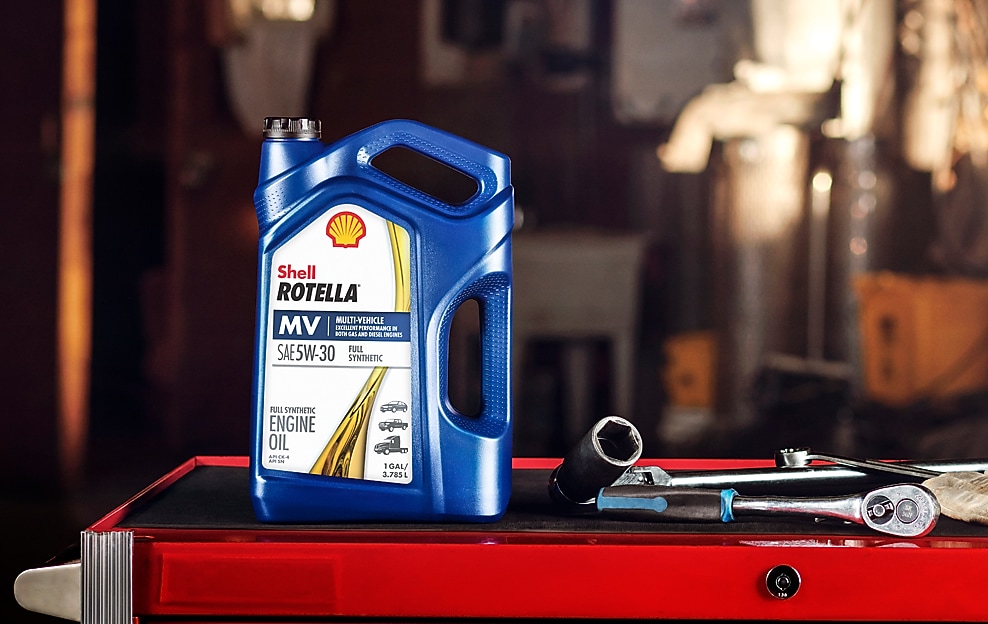
Why lower viscosity oil can be better for your engine
The smaller the first number, the better the oil will flow when you switch on your engine. Thin, low viscosity oils flow easier to protect engine parts at cold temperatures. The faster oil flows to critical parts of the engine, the more protected they are from wear.
So a 5W-30 will flow easier than a 10W-30 at start-up temperatures. And a 10W-30 will flow easier than a 15W-40 at normal engine operating temperatures.
What’s more, lower viscosity oils can reduce your fuel costs and CO2 emissions.
No matter what you put your engine through, you need to know your oil will protect your engine under all conditions. And the right quality oil matters.
Which Shell Rotella Oils Have A Lower Viscosity?
Of course, ‘lower’ is a relative term. 10W-30 is lower than 15W-40, and 5W-30 is lower than 10W-30
Before thinking of trying one of our oils, first be sure what your OEM recommends. Not all engines work with low-viscosity oils.
How do I know which oil is right for my vehicle?
Some vehicle manufacturers provide a range of recommended engine oil viscosity grades – based on the outside temperature in which the vehicle is operated, as well as the operating conditions.
Other original equipment manufacturers (OEMs) may recommend the use of only one motor oil viscosity grade. Always follow the OEM’s recommendations found in your vehicle’s owner’s manual.
Shell LubeMatch can provide recommendations based on your specific equipment.
Related Video
Shell Rotella - Role of low viscosity lubricants in fuel economy
Read the transcript
Read the transcript
The Roundup by Shell Rotella - Role of low viscosity lubricants in fuel economy
Video Transcript
Duration: 01:44
Description: Video about the role of low viscosity lubricants in fuel economy & the impact of CO2 reduction, featuring Dr. Jason Brown.
[Background music plays]
Bright, uplifting music.
[Animation sequence]
“The
Roundup
Questions – Commentary – News
by
Shell
Rotella”
Copy with a pecten next to “Shell Rotella” copy.
[Jason Brown]
Jason Brown is standing, filmed from the waist up in front of a Barcelona photo background featuring La Sagrada Familia. He is wearing a white and red polo shirt with the Shell pecten.
[Title]
Dr. Jason Brown
Global Technology Manager For Heavy Duty Diesel Engine Oils
Shell Lubricants
[Jason Brown]
Heavy duty diesel engine oil technology has changed significantly over the last 40 years.
[Jason Brown voiceover]
The focus mainly has been on particulate matter and NOx emissions. Going forward, we're going to see CO2 as a next big emission to control.
[Video footage]
Detail slow-mo shot of an engine oil being poured. Aerial timelapse of both a highway, showing vehicle traffic in both directions. Aerial shot of a green valley.
[Jason Brown voiceover]
The way to control CO2 in heavy duty diesel engines is through fuel economy.
[Animation sequence]
“Control CO2 Through
Fuel Economy”
Copy with a “CO2 ” downward facing arrow below it.
[Jason Brown voiceover]
So not only are we going to see changes in engine oil hardware, we're going to see significant changes in engine oils themselves.
[Video footage]
Detail shot of a big engine in motion. Detail shot of an engine oil being poured.
[Jason Brown voiceover]
The engine oils are gonna go to lower viscosity, which allows the engine to run more efficiently.
[Animation sequence]
“Lower Viscosity
Allows Engine To Run
More Efficiently”
Copy next to an engine icon in motion.
[Jason Brown voiceover]
But those engine oils also have to be able to evolve to give the same amount of durability that previous thick engine oils were delivering in the past.
[Video footage]
Wide shots of a white 18-wheeler truck driving down a road in the middle of a green field. Detail shot of an engine in motion.
[Jason Brown voiceover]
What is a synthetic engine oil?
[Text displays]
What Is
Synthetic
Engine Oil?
[Jason Brown voiceover]
So, a synthetic or a synthetic blend engine oil is designed from synthetic technology base oil.
[Animation sequence]
“Shell
Rotella
T5 10W-30
Synthetic Blend Technology
Triple
Protection
Plus”
Copy with Triple Protection Plus shield icon, next to a T5 10W-30 engine oil bottle.
[Jason Brown voiceover]
If we use an improved base oil technology with an improved additive technology, you can see...
[Video footage]
Detail shot of a Shell Rotella T6 Multi-Vehicle 5W-30 engine oil bottle at a shop, next to other tools. glove-clad hand grabs one of the tools. Detail shot of a male pouring engine oil in an engine.
[Jason Brown voiceover]
...benefits like longer oil drains, better protection from your engine in terms of deposits or even wear protection.
[Text displays]
Benefits:
-Longer Oil Drains
-Better Protection
[Jason Brown voiceover]
The other nice benefit is that they allow you to blend the engine oil at a lower viscosity. So you may even get the benefit of fuel economy as well.
[Text displays]
Benefits:
-Allow To Blend Engine Oil At Lower Viscosity
[Jason Brown voiceover]
It's about the entire driveline system…
[Video footage]
Various timelapse shots of mechanics working on a blue 18-wheeler truck at a shop. The Shell Rotella T6 Multi-Vehicle 5W-30 engine oil bottle is sitting next to other tools.
[Jason Brown voiceover]
...making low viscosity engine oils, transmission fluids, greases, axle, gear fluids…
[Text displays]
Low Viscosity
-Engine Oils
-Transmission Fluids
-Greases
-Axle Fluids
-Gear Fluids
[Jason Brown voiceover]
...all of the fluids that go in a piece of equipment that are designed to help that overall vehicle…
[Video footage]
Detail shot of a man finishing engine oil pour. Detail shot of a mechanic wiping his hands with a rag. Wide shot of a white 18-wheeler truck driving down a road in the middle of a green field.
[Jason Brown]
...achieve a better fuel economy percentage.
[Jason Brown voiceover]
The better the fuel economy percentage of the overall vehicle, then the better the emissions.
[Text displays]
Better Fuel Economy % = Less Emissions
[Shell music fades out]
[Animated sequence]
“Shell
Rotella”
Copy next to Shell pecten.
[Shell mnemonic]
Fuel Economy Field Trial Test Results
Read the transcript
Read the transcript
Fuel Economy Field Trial Test Results - Video Transcript
Duration: 01:44
Description: Video that provides test results from a U.S. fuel economy field trial., featuring Jason Brown.
[Background music plays]
Bright, uplifting music.
[Text Display]
“Does Changing Your
Heavy Duty Engine Oil
To Something Thinner
Save On Fuel?”
[Narrator]
Does changing your heavy duty engine oil to something thinner really save on fuel?
[Video footage]
Truck driving down highway
[Text Display]
“U.S.Fuel Economy Field Trials
6 Different Oils’
[Narrator]
To find out, we conducted field testing on six heavy duty oils.
[Jason Brown]
- This kind of fuel economy program is important to Shell, because it's about credibility, and it's about precision.
[Text Display]
“24 Days
Field Trial”
[Video footage]
Trucks in a parking lot
[Narrator]
For 24 days we ran six U.S. trucks on a test track in various weather conditions.
[Video footage]
Truck on a highway
[Text displays]
“All Tested In
Texas”
[Text Display]
“Test Measurament
Extra Urban”
[Text Display]
“Test Measurament
Urban Cycles”
[Text Display]
“Test Measurament
Highway Cycles”
[Narrator]
Each truck was tested in three cycles for long haul, depot-to-depot, and city delivery,
[Video footage]
Truck driving down highway, interior of a cab
[Narrator]
to ensure all types of operating conditions were included in the results. All measurements were standardized.
[Video footage]
Weather equipment being set up and checklist on a clipboard, trucks driving down a highway
[Matthew Urbanak Voice over]
We've got wind, we've got weather, we've got driver factors.
[Matthew Urbanak interview]
It's a much more representative fuel economy test
than anything that we could do inside a lab.
[Text Display]
Fuel Economy Measurements
[Icon Of Gas Odometer]
Reference Oil 15W-40
[Icon Of Gas Odometer]
Shell Rotella® T5 10W-30
Synthetic Blend
[Icon Of Gas Odometer]
Shell Rotella T5
Ultra 10W-30(FA-4)
[Narrator]
The results proved that thinner oil
or a lower viscosity oil, saved on fuel.
[Animation Sequence]
“What Was The
Magnitude
Of Savings?”
[Narrator]
What was the magnitude of savings?
[Animation Sequence]
Shell Rotella T5 10W-30 (CK-4) Bottle
Fuel Savings Chart Showing Shell Rotella T5 10W-30 (CK-4) Improving By 2% Compared To Reference Oil 15W-40
[Narrator]
When compared to the reference oil, 15W-40, Shell Rotella T5 10W-30 Synthetic Blend resulted in a 2% benefit.
[Animation Sequence]
Shell Rotella T5 Ultra 10W-30 Bottle
Fuel Savings Chart Showing Shell Rotella T5 Ultra 10W-30 IMPROVING BY 2.6% Compared To Reference Oil 15W-40
[Narrator]
Shell Rotella T5 Ultra 10W-30 saw a 2.6% benefit over the reference oil, 15W-40.
[Video Footage]
Truck driving on highway
[Text Display]
“Less Fuel
Mans
More
Savings”
[Video Footage]
Truck driving on highway, trucker behind the wheel, oil stick being cleaned
[Narrator]
This can equate to huge fuel bill savings, which is one of the highest costs a fleet or owner driver has.
[Video Footage]
Oil being poured into an engine
[Narrator]
This testing tells us what types of lubricants we need to develop
[Video Footage]
Overhead shot of truck driving down a highway
[Narrator]
so your heavy-duty engine is fuel efficient.
[Jason Brown Interview]
Just from the modeling and design of this type of test and the scale and effort that we've put in, I don't think anyone compares to what we've done here.
[Shell music fades out]
[Animated sequence]
“Shell
Rotella
The Engine Oil That Works As Hard As You.”
Copy fades up to reveal the Shell pecten on a white background.
www.Rotella.com appears below the pectin
[Shell mnemonic]
You May Also Be Interested In
